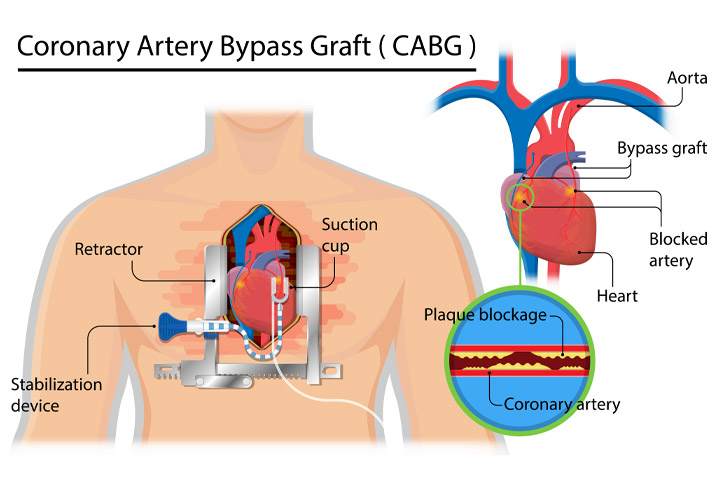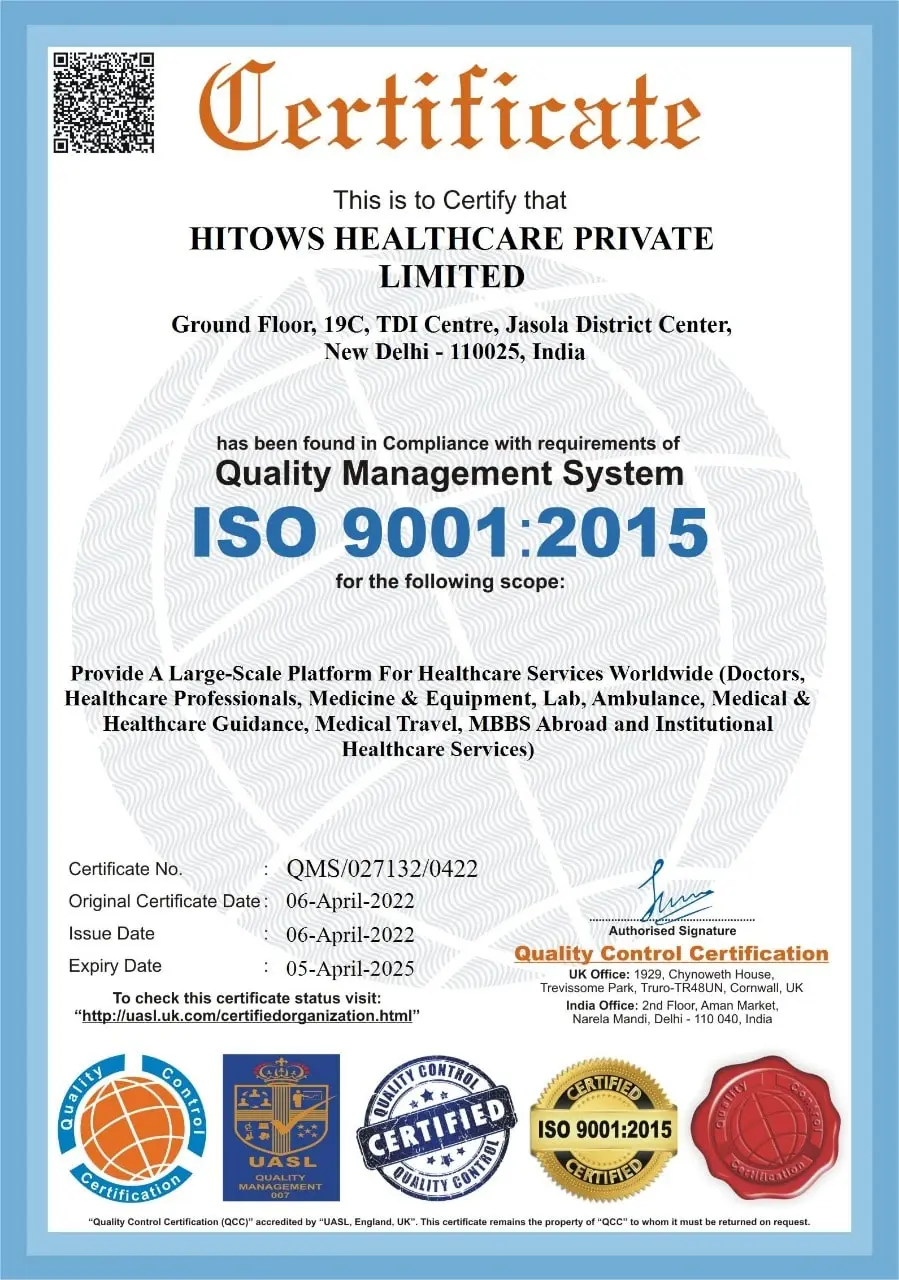Heart Bypass - Minimally Invasive CABG cost in India
The cost of Heart Bypass - Minimally Invasive
CABG in India ranges from USD 3800 to USD 7000
Procedure Description:
Heart Bypass - Minimally Invasive CABG
Heart bypass surgery establishes a new route, known as a bypass, for blood and oxygen to enter your heart. A minimally invasive coronary (heart) artery bypass can be performed without stopping the heart. As a result, you do not need to be placed on a heart-lung machine for this treatment. You will not be placed on a heart-lung machine during this surgery. You will, however, be sleepy and pain-free because to general anesthetic. A device will be attached to your heart to keep it stable. You will also be given medication to slow the heart rate.
You may have a tube in your chest that drains fluid. This will be removed within a day or two. If you have a blockage in one or two coronary arteries, most of which are in the front of the heart, your doctor may consider a minimally invasive coronary artery bypass. When one or more of the coronary arteries are partially or completely clogged, your heart does not receive enough blood. This is known as ischemic heart disease or coronary artery disease. It may induce chest pain.
Disease Overview:
Coronary heart disease
Coronary artery disease occurs when your heart's primary blood arteries become damaged or diseased. Coronary artery disease is caused by cholesterol-containing deposits (plaques) in your coronary arteries and inflammation.
The coronary arteries feed your heart with blood, oxygen, and nourishment. Plaque development can restrict these arteries, reducing blood flow to the heart. Reduced blood flow may eventually result in chest discomfort (angina), shortness of breath, or other signs and symptoms of coronary artery disease. A heart attack might be caused by a total blockage.
You may not detect a problem until you have a large blockage or a heart attack since coronary artery disease commonly develops over decades. However, there are things you may do to prevent and cure coronary artery disease.
A healthy way of living can have a significant influence.
Disease Signs and Symptoms:
If your coronary arteries constrict, they won't be able to provide your heart with enough oxygen-rich blood, especially when it's working hard, as it is during exercise. Reduced blood flow may not create any symptoms at first. However, when plaque builds up in your coronary arteries, you may experience the following signs and symptoms of coronary artery disease:
Pain in the chest (angina). As if someone were standing on your chest, you may feel pressure or stiffness in your chest. Angina is a kind of chest discomfort that often appears on the centre or left side of the chest. Angina is most commonly brought on by physical or mental strain. After ceasing the stressful activity, the discomfort normally goes away within minutes. The discomfort felt in the neck, arm or back in some people, particularly women, might be mild or severe .
Disease Causes:
If your coronary arteries constrict, they won't be able to provide your heart with enough oxygen-rich blood, especially when it's working hard, as it is during exercise. Reduced blood flow may not create any symptoms at first. However, when plaque builds up in your coronary arteries, you may experience the following signs and symptoms of coronary artery disease:
Pain in the chest (angina). As if someone were standing on your chest, you may feel pressure or stiffness in your chest. Angina is a kind of chest discomfort that often appears on the centre or left side of the chest. Angina is most commonly brought on by physical or mental strain. After ceasing the stressful activity, the discomfort normally goes away within minutes. The discomfort felt in the neck, arm or back in some people, particularly women, might be mild or severe .
Breathing problems. Shortness of breath or excessive weariness may occur if your heart is unable to pump enough blood to fulfil your body's demands.
A heart attack has occurred. A heart attack is caused by a totally clogged coronary artery. Crushing pressure in your chest, pain in your shoulder or arm, and shortness of breath and perspiration are all typical indications and symptoms of a heart attack.
Women are somewhat more likely than males to suffer less conventional heart attack signs and symptoms, such as neck or jaw discomfort. They may also have additional symptoms including shortness of breath, exhaustion, and nausea.
A heart attack can happen without any warning signs or symptoms.
Disease Diagnosis:
The doctor will inquire about your medical history, perform a physical examination, and prescribe normal blood tests. He or she may also recommend one or more diagnostic tests, such as:
An EKG is a type of electrocardiogram (ECG). An electrocardiogram (ECG) is a test that monitors electrical impulses as they pass through your heart. An ECG can often reveal signs of a past heart attack or a heart attack that is now occurring.
Echocardiogram. Sound waves are used to create pictures of your heart in an echocardiogram. Your doctor can use an echocardiography to see if all portions of your heart wall are contributing regularly to your heart's pumping action.
Parts that move slowly might have been injured during a heart attack or aren't getting enough oxygen. This might indicate coronary artery disease or other problems.
Stress test with exercise Your doctor may advise you to walk on a treadmill or ride a stationary bike during an ECG if your signs and symptoms are more common when you exercise. While you're doing these workouts, an echocardiography may be performed. This is referred to as a stress echo. Medication to boost your heart may be used instead of exercise in some circumstances.
A nuclear stress test has been performed. This test is comparable to an exercise stress test, however the ECG records are accompanied by visuals. At rest and under stress, it monitors blood flow to your heart muscle. A tracer is put into your circulation, and sophisticated cameras can identify parts of your heart where blood flow is reduced.
Catheterization and angiography of the heart. A doctor carefully inserts a catheter into an artery or vein in your groyne, neck, or arm and up to your heart during cardiac catheterization. The catheter is guided to the proper place using X-rays. Dye is sometimes injected into the catheter. The dye enhances the visibility of blood arteries on pictures and highlights any obstructions.
A balloon can be put via the catheter and inflated to enhance blood flow in your coronary arteries if you have a blockage that has to be treated. The dilated artery is usually kept open using a mesh tube (stent).
A cardiac CT scan is a type of imaging that is used to look at the inside of the heart A cardiac CT scan might reveal calcium deposits in your arteries, which can constrict them. Coronary artery disease is a possibility if a significant quantity of calcium is found.
A CT coronary angiography can provide comprehensive pictures of your heart arteries by administering a contrast dye through IV during a CT scan.
Disease Treatment:
Coronary artery disease is generally treated with a combination of lifestyle modifications, medicines, and medical procedures.
Changes in your way of life
Making the following healthy lifestyle adjustments will help promote healthier arteries:
- Stop smoking.
- Consume nutritious foods.
- Exercise on a regular basis.
- Get rid of the extra pounds.
- Reduce your stress levels.
Procedures to enhance blood flow and restore it
Sometimes a more active approach is required. Here are several possibilities:
Stent implantation and angioplasty (percutaneous coronary revascularization)
A long, thin tube (catheter) is inserted into the narrowed section of your artery by your doctor. The constricted region is reached by passing a wire with a deflated balloon via the catheter. After then, the balloon is inflated, forcing the deposits against the artery walls.
A stent is frequently left in the artery to keep it open. The majority of stents deliver medicine over time to help keep the arteries open.
Bypass surgery for the coronary arteries
A graft is a conduit from another region of your body that is used to bypass blocked coronary arteries. This permits blood to flow around the coronary artery that is obstructed or constricted. Because it necessitates open-heart surgery, it's usually reserved for patients with numerous constricted coronary arteries.
Country wise cost comparison for Heart Bypass - Minimally Invasive CABG:
| Country | Cost |
|---|---|
| India | $3870 |
| Turkey | $11007 |
| Thailand | $11007 |
Treatment and Cost
10
Total Days
In Country
- 3 Day in Hospital
- 2 No. Travelers
- 7 Days Outside Hospital
Treatment cost starts from
$4300
Popular Hospital & Clinic
Featured Hospital
0 Hospitals
Related Packages
More Related Information
Some of the top rated hospitals are:
- Turkey
- Kolan International Hospital, Sisli
- Istinye University Bahcesehir Liv Hospital
- Istinye University Medical Park Gaziosmanpasa Hospital
- I.A.U VM Medical Park Florya Hospital
- Altinbas University Medical Park Bahcelievler Hospital
- Medical Park Antalya Hospital
- Medical Park Tarsus Hospital, Mersin
- Thailand




